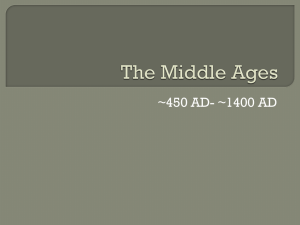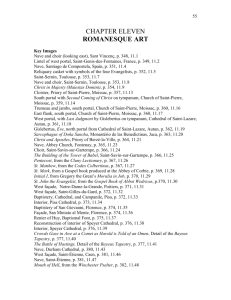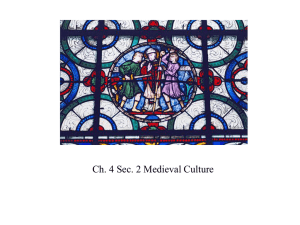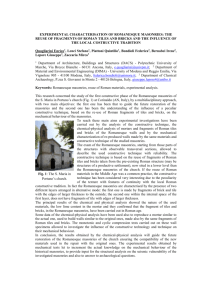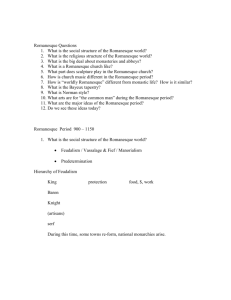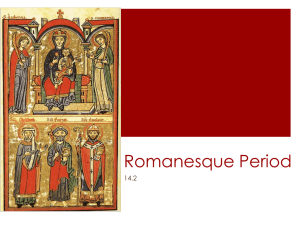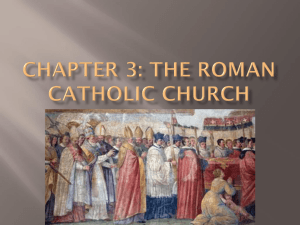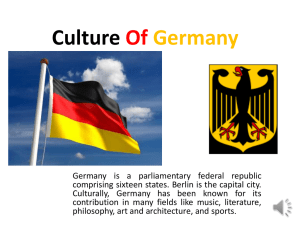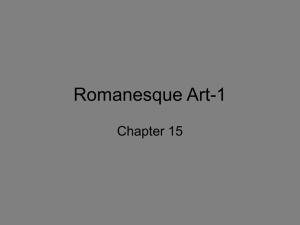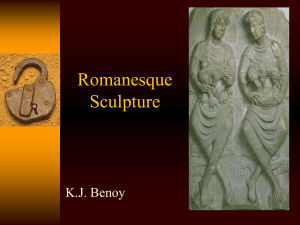chapter_15_part_2
advertisement
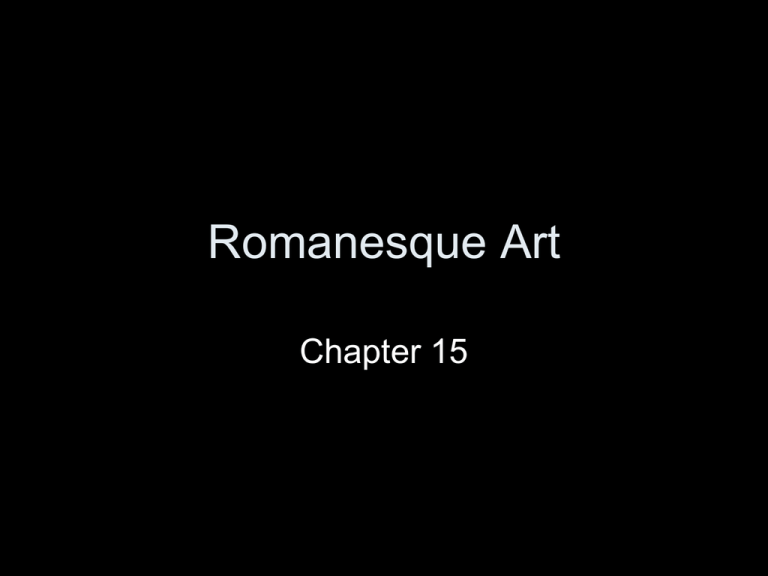
Romanesque Art Chapter 15 ROMANESQUE EUROPE (c. 1000-1200) • Romanesque appears to have been the first pan-European style since Roman Imperial Architecture and examples are found in every part of the continent. One important fact pointed out by the stylistic similarity of buildings across Europe is the relative mobility of medieval people. Contrary to many modern ideas of life before the Industrial Revolution, merchants, nobles, knights, artisans, and peasants crossed Europe and the Mediterranean world for business, war, and religious pilgrimages, carrying their knowledge of what buildings in different places looked like. Monastery of Santo Domingo de Silos, Spain. Capitol detail c. 1100 • The Romanesque was not confined only to architecture. It was accompanied by changes in design for woodworking seen, for instance in, chests and cupboards. The exterior of the book changes at this time, and as does manuscript design as scribes start to use a new clear style of writing (Caroline minuscule). Texts are set among intricate spirals and elaborate and finelydrawn nature motifs. This became an international graphic style, influencing even Jewish illuminated manuscripts. In western painting, mosaic and fresco design, from around 1150 a spirit emerged across Europe. This attempted to revive the styles of the art of classical antiquity, and yet it also drew heavily on ancient Christian Celtic and Byzantine arts. The Main Characteristics of the Style • A combination of masonry, arch and piers is the basis of the Romanesque style. The main concept for buildings was the addition of pure geometrical forms. The new concept of stone vaulting required stronger walls for support. Because of the lack of knowledge of the building statics it was necessary to build strong, thick walls with narrow openings. • The Pier (an upright support generally square, or rectangular in plan) is a better solution for masonry walls, than the column. Columns are subsequently replaced by piers, or transformed to better support the masonry arches. Geometrisation and rigidity in Romanesque architecture is evident in the transformation of column capitals from Corinthian to cubic capitals, as found in the church of St.Michael, Hildesheim. There is also one new element in the capitals developed during Romanesque period - the impost. It's a trapezoid form which stands between capital and arch. Some important aspects of Romanesque architecture • • • • • “Romanesque” is the first international style since the Roman Empire. Competition among cities for the largest churches, which continues in the Gothic period via a “quest for height.” Masonry (stone) the preferred medium. Craft of concrete essentially lost in this period. Rejection of wooden structures or structural elements. East end of church the focus for liturgical services. West end for the entrance to church. • Church portals as “billboards” for scripture or elements of faith. • Cruciform plans. Nave and transept at right angles to one another. Church as a metaphor for heaven. • Elevation of churches based on basilican forms, but with the nave higher than the side aisles. • Interiors articulated by repetitive series of moldings. Heavy masonry forms seem lighter with applied decoration. • Bays divide the nave into compartments • Round-headed arches the norm. • Tripartite division of the elevation continues from the earlier periods. • The Romanesque period, from roughly 1000 to 1137 A.D., has been dubbed the "Period of the Church Triumphant." It was during these years that the Catholic Church was able to unify Western Europe in a manner unparalleled since Roman times. This is the Age of Monasticism, when vast monastic settlements like Cluny were becoming the focus of both the religious and scholarly life of the Romanesque populace. • This is also the Age of the Crusades, when Western Christians sought to "liberate" the Holy Lands. Both of these features (monasticism and the Crusades) spurred the economy, for the churches required mighty building campaigns and the Crusaders (as a consequence of their mobility) opened up new trade routes and spurred commerce. It has been noted that the cosmopolitan quality of Romanesque culture was reminiscent of Roman imperial times; it is equally appropriate to compare the unifying power of the Pope during the 11th century A.D. with that of the Roman Emperor. There are good cultural reasons, thus, for naming this period "Romanesque." Political and Economic Life The social and economic classes become vividly clear in the Worcester Chronicle, which depicts the three classes of Medieval society: • King and Nobles • Churchmen • Peasant farmers King Henry I's Dream in the Chronicle of John of Worcester. The author died in 1140 AD so it's from before that. Original work by John of Worcester. King Henry I and his Court returning to England from The Chronicle of John of Worcester Intellectual Life • The 11th and 12th centuries were a time of intellectual rebirth as Western scholars rediscovered the classical Greek and Roman texts that had been preserved in Islamic Spain and the eastern Mediterranean. The first universities were established in the growing cities – • Bologna • Paris • Oxford • Cambridge Romanesque Art • The word Romanesque means “In the Roman manner.” • The word was coined in the 19th century to describe European church architecture, which often displayed solid masonry walls and rounded arches and vaults characteristic of imperial Roman buildings. Interior, Church of Sant Vincenc, Cardona 1020s – 1030s Church of Sant Vincenc, Cardona 1020s – 1030s Pilgrimage Churches • The growth of a cult of relics and the desire to visit shrines such as Saint Peter’s in Rome or Saint James in Spain inspired people to travel on pilgrimages. Christian victories against Muslims also opened roads and encouraged travel. Plan of Cathedral of Saint James, Santiago De Compostela Durham Cathedral Durham, England early 12th century Reliquary Statue of St. Foy from the Auvergne region, France Silver gilt over wood core, with gems and rock crystal Late 9th century with later additions This complex contains a baptistry, a church and a bell tower. The bell tower or campanile is the most famous of all. The "Leaning tower of Pisa" is 6 stories of arcaded galleries. Round arches were a Roman inspiration. The foundation lies on tufu and is sinking. Efforts have been tried to raise it upright. Most of them have been disastrous and nearly destroyed the tower, such as when they flooded the foundation with water to "float" the tower, which only made it lean more. It is 13 feet out of plumb. • The Baptistry of Pisa is part of the church complex, and as with most baptistries, is usually round or octagonal in shape. The sacrament of baptism is administered. Inside is a baptismal front, a receptacle of stone or metal which holds water for the rite. **NOTE: The baptistry also kept accurate population records in bean jars, a jar for girls and a jar for boys. As one is born or dies the bean is added or subtracted from the jar. Church of Saint-Étienne Caen, France 1067-1120 Church of Sant’Ambrogio Milan, Italy 1080-1117 Creation and Fall Wiligelmus, sculptor Modena Cathedral Modena, Italy 1106-1120 Cathedral of Saint-Lazare West Portal Last Judgment Autun, France ca. 1120-1135 Cathedral of Saint-Lazare West Portal Last Judgment Church of Saint-Pierre Moissac, France South Portal ca. 1115-1130 Trumeau figure— the Prophet Jeremiah Virgin and Child from the Auvergne region of France Painted wood late 12th century Batlló Crucifix from Catalonia, Spain Painted wood mid 12th century Church of Saint-Savin-surGartempe France ca. 1100 Christ in Majesty Church of San Clemente, Lérida, Spain Fresco ca. 1123 The Bayeux Tapestry England or France wool embroidery on linen ca. 1066-1082 The Bayeux Tapestry - detail The Bayeux Tapestry Detail Hildegard and Volmer Liber Scivias (reproduction) 1165-1175 Cast bronze baptismal font by Renier de Huy, 1107–18. In the church of SaintBarthélemy, Liège, Belgium. Height 64 cm. Romanesque metalwork • In the 12th century the church supplanted secular rulers as the chief patron of the arts, and the work was carried out in the larger monasteries. Under the direction of such great churchmen as Henry, bishop of Winchester, and Abbot Suger of SaintDenis, near Paris, a new emphasis was given to subject matter and symbolism. • Craftsmen were no longer anonymous; work by Roger of Helmarshausen, Reiner of Huy, Godefroid de Claire (de Huy), Nicholas of Verdun, and others can be identified; and the parts they played as leaders of the great centers of metalwork on the Rhine and the Meuse are recognizable. Their greatest achievement was the development of the brilliant champlevé enameling, a method that replaced the earlier cloisonné technique. Gold and silver continued to be used as rich settings for enamels; as the framework of portable altars, or small devotional diptychs or triptychs; for embossed figure work in reliquary shrines; and for liturgical plate. • The masterpieces of the period are great house-shaped shrines made to contain the relics of saints; for example, the shrine of St. Heribert at Deutz (c. 1160) and Nicholas of Verdun's Shrine of the Three Kings at Cologne (c. 1200). In the latter, the figures are almost freestanding, and in their fine, rhythmic draperies and naturalistic movement they approach the new Gothic style. Detail of baptismal font by Renier de Huy Page with the Tree of Jesse Explanatio in Isaiam (St. Jerome’s commentary on the book of Isaiah) Burgundy, France ca. 1125 Page with Hellmouth (Angel locking the gates of Hell) Winchester Psalter Winchester, England ca. 1150 Page with self-portrait of the nun Guda Book of Homilies from Germany early 12th century First self-portrait of a Woman artist.

